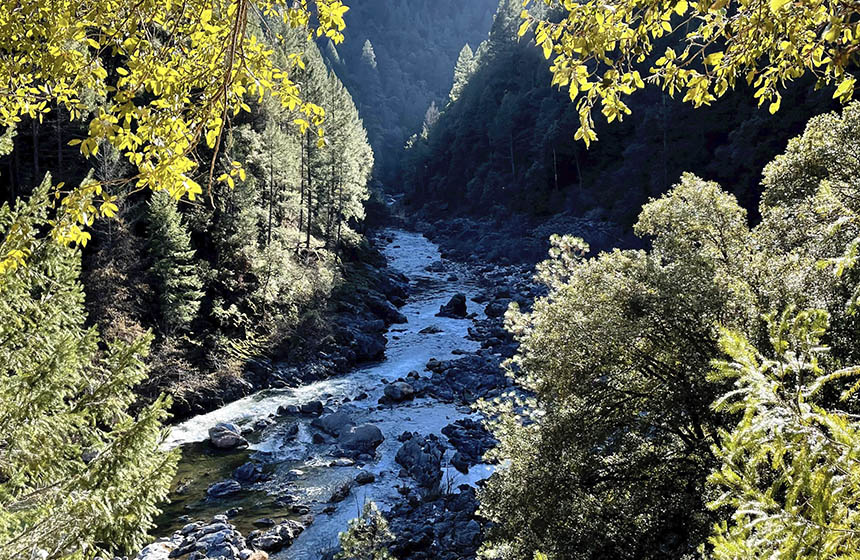Yuba river watershed forest management
The Yuba Project utilizes Forest Resilience Bonds(FRB) in order to generate private finance to front the costs of forest management and restoration allowing for faster project completion.
Nature-based Intervention:
The project implements fuels reduction techniques to reduce local fire risk restore the forest to a resilient state. The National Forest Foundation took the lead on ensuring resilience to changing climatic conditions for approximately 5,690 acres. This work included reducing surface and ladder fuels to a level that would allow safe fire suppression and improving wildlife habitat. This includes 2,262 acres of general fuels reduction in the project area and 480 acres of aspen and meadow restoration. They will also utilize 3,104 acres of underburning and prescribed fire in order to safely reintroduce natural fire cycles into the ecosystem.
Overview of context and outcomes:
The mobilization of private funds through financing has made it possible for the Tahoe to accelerate work and complete projects in just four years instead of the projected 10 to 12 years. The success of the FRB and the collaboration developed in order to deliver this project has laid the groundwork for a new regional partnership to support forest management activities. The partnership announced in 2019 includes nine federal, state, tribal and nongovernmental partners, and together they established the North Yuba Forest Partnership. This collaborative will have a similar focus on restoring forests and manage 275,000 acres of public and private lands in Northern California.
Case effectiveness on
Climate change
The project reportedly helps reduce carbon emissions through treatments which increase growth rates for large trees and understory vegetation. The efforts to reduce forest fuel and prevent high-intensity large scales fires also help prevent mass releases of carbon and particulate matter which occurs during uncontrolled wildfires.
Through thinning the forest and strategic burning to reduce fuel loads, the project reportedly helps to reduce the risk of high intensity fires which threaten communities and ecosystems. Through reducing the overgrown state of the forest, the project has also reportedly increased stream discharge allowing for more water to reach downstream communities which are often impacted by drought.
Ecosystem health
Ecological effect: PositiveThese interventions have reportedly led to a reduction in ecological vulnerability and an increase in habitat quality. The forest biomass reduction efforts and meadow restoration allowed for the the ecosystem to revert to a historic open forest with a natural low intensity fire cycle. The reduction of high intensity fires also reportedly helps improve water quality through reductions in pollutants and particulate matter entering the streams.
Socioeconomic outcomes
This intervention reportedly helps increase water availability and quality for local communities, while simultaneously reducing their risk to large-scale fires.
Governance
The project is implemented by the Tahoe National Forest who is working with the National Forest Foundation in order to implement work on the ground which is governed through a Master Stewardship Agreement. The financial aspects a governed in a partnership between Blue Forest Conservation and the Tahoe National Forest with the State of California and the Yuba Water Agency as financial stakeholders.
Finance
The project used FRB to generate $4 million in private capital from four investors in order to finance the ecological restoration treatments at the site. The The State of California and the Yuba Water Agency are now repaying investors at a set contract rate as restoration work is completed.
Monitoring and evaluation
Blue Forest Conservation is leading an analysis in order better understand to water supply impacts due to the actions of this intervention.
Trade-offs and limitations
No information yet available on tradeoffs.

Intervention type
- Management
- Restoration
Ecosystem type
- Montane/Alpine
Climate change impacts addressed
- Reduced water availability
- Wildfire
Instigators
- State/district/local government agency
- Local private sector
Societal challenges
- Biodiversity conservation
- Climate change adaptation
- Climate change mitigation
- Disaster risk reduction
- Water security
Outcomes
- Food security: Not reported
- Water security: Positive
- Health: Not reported
- Local economics: Not reported
- Livelihoods/goods/basic needs: Not reported
- Energy security: Not reported
- Disaster risk reduction: Positive
- Rights/empowerment/equality: Not reported
- Conflict and security: Not reported
- No. developmental outcomes reported: 4
Resources
Read resource 1Read resource 2
Literature info
- Grey literature



